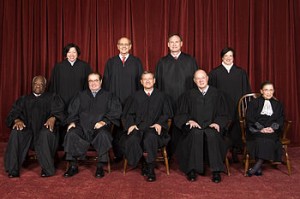 In a 5-4 decision, the U.S. Supreme Court upheld the Obama Administration’s signature Health Care Law, the Patient Protection & Affordable Care Act (“Affordable Care Act”) on Thursday, June 28.
In a 5-4 decision, the U.S. Supreme Court upheld the Obama Administration’s signature Health Care Law, the Patient Protection & Affordable Care Act (“Affordable Care Act”) on Thursday, June 28.
A full report and analysis of the Court’s opinion is found at Supreme Court Upholds Health Care Law – Individual Mandate Upheld as a Tax; Medicaid Expansion Made Voluntary to States.
In reaction to the Court’s ruling, some Conservatives have accused Chief Justice John Roberts of “judicial activism” and criticized him for “siding with the liberals” on the Court to uphold the individual mandate.
At the same time, some Liberal commentators expressed surprise and even questioned whether Justices Kagan and Breyer were “traitors” or “voted against their President” when they sided with Chief Justice John Roberts in striking down the authority given to the Secretary of Health & Human Services (HHS) to deny states funding for their existing Medicaid programs, as a penalty, if they failed to participate in the Medicaid Expansion under the Affordable Care Act. In striking down only this authority to deny funding for existing Medicaid programs, which would effectively have forced all states to participate in the Expansion, the Court left the law’s Medicare Expansion in effect only as a voluntary program for the states.
But a review of how the Justices actually voted on the issues before the Court, and their own words, paint a different picture than that suggested by the partisan commentators. Analysis of how the Justices voted suggests a possible compromise may have been reached between Chief Justice Roberts and the Liberal Justices on the Court. The Justices’ own words in their opinions reflect an adherence to the principles of judicial restraint, which may have propelled those exercising the “swing votes” to reach the compromise they apparently did.
How the Justices Ruled on the Health Care Law
Below is a summary showing how the Supreme Court Justices voted on the issues decided by the Court:
The Individual Insurance Mandate:
Voted to uphold the individual insurance mandate under Congress’ Taxing Power under the Constitution. Majority opinion by Chief Justice Roberts said the individual mandate could not also be upheld under the Commerce Clause of the Constitution.

Voted with the Majority to uphold the individual insurance mandate under Congress’ Taxing Power, but stated they would also have upheld the mandate under the Commerce Clause.

Voted to strike down the individual insurance mandate entirely, and would have stricken down the entire Health Care Law. Joint Dissenting Opinion.

Medicaid Expansion:
Voted to preserve Medicaid Expansion as a Voluntary Program, Striking only the Penalty Provision for Non-Participating States. Majority opinion by Chief Justice Roberts.

Voted to strike down the Medicaid Expansion in its entirety, and would have stricken down the entire Health Care Law. Joint Dissenting Opinion.

Commentary and Analysis of How the Justices Voted
By Voting with Chief Justice Roberts on Medicaid, Justices Kagan & Breyer and the Concurring Justices Actually Saved the Medicaid Expansion as a Voluntary Program.
In reaching this decision on the Medicaid expansion, two of the Justices appointed to the Court by Democratic Presidents (Breyer and Kagan) voted with Chief Justice Roberts to strike down only the penalty provision for non-participating states, while preserving the Medicaid expansion intact as a voluntary program. The Concurring Justices (Ginsburg and Sotomayor) also voted with the Chief Justice on this point.
As referenced above, many commentators have expressed surprise at this result, with some Liberals accusing Justices Kagan and Breyer of “voting against their President.”
What seems to have escaped notice by most commentators and the media — but is obvious by looking at the above pictorial illustration of how the Justices voted — is that by siding with Chief Justice Roberts in striking only the penalty provision in the Medicare Expansion, to which he objected, Justices Breyer and Kagan (and Ginsburg and Sotomayor in concurring), actually placed Justice Roberts’ limited view in the majority, thereby saving the rest of the Medicaid Expansion in the law — at least as a voluntary program.
By voting with Justice Roberts to allow him to take a scalpel to the mandatory part of the Medicaid expansion to which he objected, they placed him in a majority with his view that the remainder of the Medicaid Expansion should be saved as a voluntary program. Otherwise, presumably Justice Roberts’ vote of “No” to a part of the Medicaid Expansion would have placed him with the four other “No” votes on the Medicaid Expansion — all of whom favored striking the entirety of the Medicaid Expansion and the entirety of the Law.
With five Justices opposing some or all of the Medicaid expansion (the four dissenters plus Chief Justice Roberts), if the Liberal Justices on the Court had refused to join with Chief Justice Roberts in voting to strike only the penalty provision, the meaning of the Court’s opinion on the Medicaid Expansion would have been blurred and cast in doubt. Chief Justice Roberts in that case could very likely have been counted as a “No” vote on the Medicaid Expansion — along with the four dissenters.
With four of the five “No” vote Justices voting to strike the entire Medicaid Expansion, the decision would have been at best ambiguous, but could very likely have been read as striking down the entire Medicaid Expansion.
Therefore, it is obvious that in joining with Chief Justice Roberts to strike only the penalty provision, Justices Kagan and Breyer, (and Sotomayor and Ginsburg in concurring in that vote), actually saved the Medicaid Expansion – at least as a voluntary program – and gave clarity to the Court’s majority opinion upholding the Medicaid Expansion as a voluntary program.
Why Did Justice Roberts Vote to Uphold the Individual Mandate?
CBS News reported that Justice Roberts had initially voted with the Dissenting Justices to strike down the individual mandate, but later changed his mind and voted to uphold it under the Taxing Power of Congress.
That news report focused on the fact that “There were countless news articles in May warning of damage to the Court – and to Roberts’ reputation – if the Court were to strike down the mandate,” as a potential explanation for why Justice Roberts may have had a change of heart.
But, looking at the above pictorial illustration of how the Justices voted, begs another question: Could it be possible that, moved to resolve and bring clarity to the Medicaid portion of their opinion (which otherwise would have been in doubt, as described above), the Justices in fact reached a compromise whereby Justice Roberts voted with the Liberal Justices to uphold the individual mandate – not under the Commerce Clause but under the Taxing Power – in exchange for the Liberal Justices’ voting with Justice Roberts to strike down only the penalty portion of the Medicaid expansion, while saving the rest of the Medicaid expansion?
Or, could the issue of “severability” have driven Justice Roberts’ decision? It is clear from their Dissenting Opinion, that the other four Conservative Justices (Kennedy, Alito, Scalia, Thomas) all voted that the individual mandate was not severable from any part of the rest of the Health Care Law, such that striking down the mandate would require striking down the entire Health Care Law.
Justice Roberts’ own view on severability is not known. But if he accepted the Conservative Justices’ view on severability, could this have driven Justice Roberts to look for grounds to uphold the mandate, in order to fulfill what he perceived as his duty of judicial restraint (under which laws of Congress must be presumed Constitutional), so as to uphold the balance of the Health Care Law?
The Government, in fact, argued to the Court that the individual mandate was not severable from important other portions of the law. If Justice Roberts or any of the Liberal Justices accepted the Government’s arguments on severability, then they would have been forced to grapple with just how much of the approximately 2,000 page law should be stricken down, if the mandate were to be stricken. Could this have driven Justice Roberts to conclude that the only workable solution, based on principles of judicial restraint was to uphold the mandate?
We will never know the answers to these questions. However, the fact that the majority opinion written by Chief Justice Roberts begins with an unusually long discussion of why he believes that the individual mandate is NOT supported by the Commerce Clause does suggest that the Court may have originally voted to strike down the mandate, and later reached a compromise changing this on grounds of the Taxing Power. In the Court’s majority opinion, the dispositive holding on the Taxing Power was in fact discussed only AFTER a long discussion of the Commerce Clause – almost as an after-thought.
Under the doctrine of judicial restraint, Courts are not supposed to reach issues which – though presented by the litigants – need not be decided in that they will not affect the outcome, given the Court’s holdings on other issues presented. (See discussion in Supreme Court Upholds Health Care Law – Individual Mandate Upheld as a Tax; Medicaid Expansion Made Voluntary to States.)
Had a majority of the Justices voted initially to uphold the individual mandate on the basis of the Taxing Power in the Constitution, one would expect, in an exercise of judicial restraint, that the Court’s majority opinion would first have discussed the dispositive issue upholding the mandate as a tax under the Taxing Power.
Having reached this controlling outcome, it was in fact irrelevant to the outcome whether the mandate would also have been supported under the Commerce Clause. A law of Congress supported by any one of Congress’ Constitutionally enumerated powers is valid, and it becomes irrelevant to the outcome whether such law would also be supported by other enumerated powers of Congress. In this circumstance, under accepted legal doctrine, a Court strictly exercising judicial restraint would, in fact, have declined even to reach or decide the Commerce Clause issue.
The fact that the Court’s majority opinion did reach and discuss at length a finding that the Commerce Clause would not have supported the individual mandate — before even discussing the validity of the mandate under the Taxing Power, which actually controlled the outcome — certainly suggests that the Court’s original vote may have been altered, perhaps by a compromise reached among the Justices.
Could it be that, as part of such a compromise, in exchange for voting with the Liberal Justices to uphold the mandate under the Taxing Clause, Justice Roberts insisted on leaving the lengthy (though strictly irrelevant) discussion of the Commerce Clause in the majority opinion? Though strictly irrelevant to the outcome of the case, this discussion at least makes it clear to Conservatives that Justice Roberts in fact generally shared the views of the dissenting Conservative Judges on the Commerce Clause issue.
Could it be that the Justices who were appointed by Democratic Presidents agreed to this and agreed to vote with the Chief Justice on his narrow view invalidating the penalty provisions of the Medicaid expansion, in exchange for Justice Roberts’ vote upholding the mandate under the Taxing Clause, thereby saving the Health Care Law nearly in its entirety?
Again, we will probably never know whether such overt compromises were in fact reached among the Justices. It could certainly be that each Justice reached his or her final vote on all issues purely on principle and independent reasoning.
But, from a political/ ideological point of view, Justice Roberts’ vote to uphold the mandate under the Taxing Power and Justices Kagan and Breyer’s votes (along with the Concurring Justices) to strike down a portion of the Medicaid expansion (a centerpiece of the Affordable Care Act), making it voluntary to the states, certainly do seem unexpected. This again raises the question of whether the Justices may have worked out a reasonable compromise.
When the dust settles, and calmer minds analyze the actual results flowing from the Court’s decision, it may well be that it is viewed as bi-partisan – especially when the impact flowing from upholding the individual mandate is balanced against the actual results of making the Medicaid expansion voluntary.
An exercise of Judicial Restraint.
Setting aside commentary and conjecture, it may well be that the best explanation for why the Justices who exercised the “swing votes” that decided the case voted as they did is found in their shared commitment to the principle of judicial restraint, as expressed in their own words in their opinions.
In fact, in reaching their positions, both Chief Justice Roberts and the Concurring Justices (including Justices Ginsburg, Sotomayor, Breyer and Kagan) seem to have been exercising judicial restraint. Their own words in their opinions, show that they all sought to find a way to uphold to the maximum extent possible under the Constitution a statute passed by the duly elected representatives of the People, rather than attempt to make sweeping legislative decisions themselves.
Upholding the Individual Mandate.
In upholding the individual mandate as clearly within Congress’s Taxing Powers under the Constitution, Chief Justice Roberts wrote, “Because the Constitution permits such a tax, it is not our role to forbid it, or to pass upon its wisdom or fairness.”
As to whether the Affordable Care Act should be read as merely imposing a regulation through the individual mandate (which could only be supported under the Commerce Clause) or as imposing a tax on those who fail to comply with the mandate, the Court said: “[I]t is well established that if a statute has two possible meanings, one of which violates the Constitution, courts should adopt the meaning that does not do so.”
The Court’s Syllabus accompanying its opinion explained that “Because ‘every reasonable construction must be resorted to, in order to save a statute from unconstitutionality,’ the question is whether it is ‘fairly possible’ to interpret the mandate as imposing such a tax.” Exercising such deference to preserve the Affordable Care Act from unconstitutionality, as a matter of judicial restraint, the majority of the Justices answered that question “Yes,” concluding that it was “fairly possible” to construe the individual mandate as a tax, which was within Congress’ Taxing Power under the Constitution.
“The Government asks us to interpret the mandate as imposing a tax, if it would otherwise violate the Constitution. Granting the Act the full measure of deference owed to federal statutes, it can be so read,” the Court concluded.
The Concurring Opinion similarly cited past precedents recognizing the judicial duty to presume any statute Constitutional, and defer to Congress in matters of policy.
Upholding as Much as the Justices Could Agree was Possible of the Medicaid Expansion.
In upholding the Medicaid Expansion in the Affordable Care Act, except only for the provisions of Section 1396c (giving HHS the authority to deny funding for a State’s existing Medicaid programs as a penalty for its refusing to participate in the new expansion), the majority again cited principles of judicial restraint.
The majority narrowly found that “The constitutional violation is fully remedied by precluding the Secretary from applying §1396c to withdraw existing Medicaid funds for failure to comply with the requirements set out in the expansion,” and therefore held that “The other provisions of the Affordable Care Act are not affected.”
In deference to Congress, which characterizes judicial restraint, the Court found that “Congress would have wanted the rest of the Act to stand, had it known that States would have a genuine choice whether to participate in the Medicaid expansion.”
Similar language espousing principles of judicial restraint and deference to laws of Congress is found in the Concurring Opinion.
More Information
To read for yourself the Affordable Care Act, President Obama’s signature Health Care Law, and find out what it in it, see HealthCare.gov, where you will find the full text of the Affordable Care Act, along with a Section by Section presentation and analysis of what is in it.
See related HelpingYouCare™ reports on:
President Obama Lays Out Contents of Health Care Law
Transcripts of Supreme Court Arguments on Health Care Law Suggest Possible Support for the Law (predicting the outcome, based on transcripts of the oral arguments)
Supreme Court Hears Arguments on Health Care Law March 26-28, 2012 (outlining the issues that were before the Supreme Court)
U.S. Government Appeals Health Care Law Litigation to Supreme Court (outlining the issues appealed to Supreme Court, and the background of the litigation on the Health Care Law)
11th Circuit Appeals Panel Strikes Insurance Mandate, Upholds Rest of Health Care Law (detail on the 11th Circuit Court Opinion that was under review by the Supreme Court)
For more news and information on the Patient Protection & Affordable Care Act (which some call “Obamacare”) and health care reform, see the HelpingYouCare™ resource pages on VoicesForCare™, including:
- News on Health Care Reform;
- Editorials: What Needs Improvement, With Your Comments;
- Advocacy: Proposals for Reform, With Your Comments;
- Legislation: Pending & Recently Adopted; and
- International Health Care Compare: Information on Health Care & Long-Term Care Solutions in Other Countries.
_____________
Copyright © 2012 Care-Help LLC, publisher of HelpingYouCare™. All rights reserved.
Editor’s Note: The author of this article, Constance R. Barnhart, is a practicing attorney and Managing Member at Barnhart Law PLC. She is also the founder and Editor of the HelpingYouCare™ website.
NOTICE: If you are reading this article on any website other than HelpingYouCare.com, please click HERE to go to the original article. No website other than HelpingYouCare™ has been given permission to publish this article.












Recent Comments from our Online Community